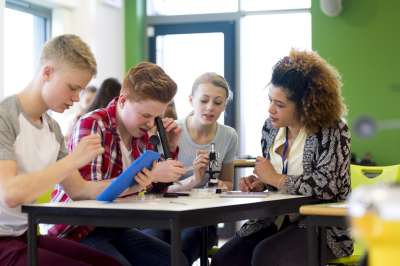A Sample Lesson
Expert Opinion
For variety, consider three types of cooperative learning groups:
Informal: ad hoc groups that last from a few minutes to a class period
Formal: lasting from several days to several weeks—they offer the time necessary to completely understand an assignment
Long-term: groups that last for a semester or the entire year and provide students with sustained support over a long period of time
Here's a lesson using the Jigsaw cooperative learning strategy:
Malinda Coons thoroughly enjoys teaching social studies to her third-grade students in San Diego. One of the topics she covers each year focuses on specific geographical regions of the United States, and she has prepared a unit on North American deserts. This year she's using the Jigsaw cooperative learning strategy as part of her lesson plan on the Sonoran Desert of the American Southwest.
Presentation of content. Melinda's students are asked to read the chapter in the social studies textbook about the Sonoran Desert. Afterward, Malinda reads students the children's book Around One Cactus: Owls, Bats and Leaping Rats by Anthony D. Fredericks (a story about the animals that live around a Saguaro cactus—particularly nocturnal animals). Her students are excited about the strange and wonderful animals that live in the desert. Finally, Malinda shows a video about desert life that was filmed by a friend who lives in Tucson, Arizona.
Teamwork. Melinda divides her class into five separate groups of five students. Each member of a group is given a different assignment; for example, in the first group, Tyrone is responsible for researching the animals of the desert; Elena is charged with learning about the plant life of the desert; Ramon is responsible for checking out the climate of the Sonoran desert; Sarah is assigned the Native American cultures that live in the desert; and Clarice will read about important desert towns and cities.
Each person goes off to do her or his individual research. To help this process, each student also meets with students who have the identical assignment (one from each jigsaw group). For example, students assigned to the “Animals of the Desert” group meet as a team of specialists, gathering information, becoming experts on their topic, and rehearsing their presentations (this is an “expert” group).
After each student has completed her or his research, she or he comes back to the original jigsaw group. Each person presents a report to the group. For example, the “Animal Expert” (Tyrone) in each group teaches the other group members about desert animals. The “Climate Expert” (Ramon) shares what he has learned with the entire team. Each student in each group educates the whole group about her or his specialty. Each person in the group listens carefully to the information presented by a teammate, asking questions for clarification.
Individual assessment. Upon the completion of the cooperative learning activity, Malinda gives each student a quiz on the desert. Students know ahead of time the components of that quiz because they were the same components they studied in their cooperative learning groups (animals, plants, climate, Native American cultures, and towns and cities).
Team recognition. Every individual in the class makes significant achievement on the quiz. Malinda takes time to acknowledge the work and effort of all five teams in helping their individual members improve. The entire class is rewarded with an extra 15-minute recess period.
Cooperative learning can be a teaching tool that helps you have a positive impact on your students' comprehension of important information. In fact, it might well be one of the most flexible and powerful strategies you can use.








